|
|
|
Sort Order |
|
|
|
Items / Page
|
|
|
|
|
|
|
| Srl | Item |
| 1 |
ID:
163921
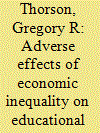

|
|
|
|
|
| Summary/Abstract |
One of the most important economic trends of the past 30 years has been the escalating levels of within-country income inequality. Much of the developed world is currently experiencing large increases in income inequality. Indeed, income inequality in the United States now exceeds the previous highs of the 1930s. Recent research has found that increases in income inequality can produce a wide variety of societal ills. This article examines the effects of economic inequality on educational outcomes. Drawing on data provided by the World Bank and the Organisation for Economic Co-operation and Development (OECD) from 2000 through 2015, we find that a country’s level of economic inequality has large, negative effects on its student academic achievement. The effect sizes are largest in math. We examine a variety of potential solutions to lessen within-country economic inequality.
|
|
|
|
|
|
|
|
|
|
|
|
|
|
|
|
| 2 |
ID:
164421
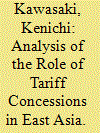

|
|
|
|
|
| Summary/Abstract |
While many studies focus on the impact of trade agreements, the literature has not focused on the extent of their implementation, in terms of the aspects agreed upon therein. In this article, we identify the past achievements of economic partnership agreements (EPAs) in the East Asian region in terms of tariff removals and suggest room for further economic benefits from trade liberalisation in the region. Second, we incorporate the HS6-level tariff concession dataset, which distinguishes between tariff removals agreed in these EPAs in East Asia but not yet implemented, from existing overall tariffs in 2011, in the Global Trade Analysis Project (GTAP) Database, which only incorporates enforced tariff reductions through the base-year applied tariffs. To analyse future trade integration, we include commitments that are not yet implemented. This allows us to analyse partial versus full enforcement of tariff concession commitments. Our results suggest that taking those commitments into account matters economically in East Asia.
|
|
|
|
|
|
|
|
|
|
|
|
|
|
|
|
| 3 |
ID:
127907
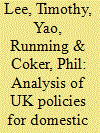

|
|
|
|
|
| Publication |
2014.
|
| Summary/Abstract |
This paper introduces a new agent-based model, which incorporates the actions of individual homeowners in a long-term domestic stock model, and details how it was applied in energy policy analysis. The results indicate that current policies are likely to fall significantly short of the 80% target and suggest that current subsidy levels need re-examining. In the model, current subsidy levels appear to offer too much support to some technologies, which in turn leads to the suppression of other technologies that have a greater energy saving potential. The model can be used by policy makers to develop further scenarios to find alternative, more effective, sets of policy measures. The model is currently limited to the owner-occupied stock in England, although it can be expanded, subject to the availability of data.
|
|
|
|
|
|
|
|
|
|
|
|
|
|
|
|
| 4 |
ID:
130618
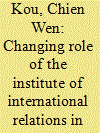

|
|
|
|
|
| Publication |
2014.
|
| Summary/Abstract |
In the past six decades, Taiwan's China studies have undergone a gradual shift from a focus on policy analysis and political introduction to one that is centred on scholarly research with policy analysis as its secondary aim. During this process, the role of the IIT has shifted from that of a government think thank, monopolizing China studies and serving the top brass jointly with other state-dominated research units, to a competitor for academic achievement and policy influence in a pluralistic academic and political market.
|
|
|
|
|
|
|
|
|
|
|
|
|
|
|
|
| 5 |
ID:
126841


|
|
|
|
|
| Publication |
2014.
|
| Summary/Abstract |
The energy sector is the biggest contributor of anthropogenic emissions of greenhouse gases into the atmosphere in Iran. However, abundant potential for implementing low-carbon technologies offers considerable emissions mitigation potential in this sector, and technology transfer is expected to play an important role in the widespread roll-out of these technologies. In the current work, globally existing low-carbon energy technologies that are compatible with the energy sector of Iran are identified and then prioritised against different criteria (i.e. Multi Criteria Decision Analysis). Results of technology prioritisation and a comprehensive literature review were then applied to conduct a SWOT analysis and develop a policy package aiming at facilitating the transfer of low carbon technologies to the country. Results of technology prioritisation suggest that the transport, oil and gas and electricity sectors are the highest priority sectors from technological needs perspective. In the policy package, while fuel price reform and environmental regulations are categorised as high priority policies, information campaigns and development of human resources are considered to have moderate effects on the process of technology transfer.
|
|
|
|
|
|
|
|
|
|
|
|
|
|
|
|
| 6 |
ID:
091529
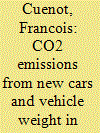

|
|
|
|
|
| Publication |
2009.
|
| Summary/Abstract |
A segment- and fuel-disaggregated analysis of the production data of the new European vehicle market during the last decade helps to understand the sharp increase in average weight, and to introduce an indicator linking CO2 emissions to a vehicle's unit of weight. Using this indicator, simulations are made to calculate the average CO2 emissions if the average weight had stayed constant from 1995 to 2005. If the weight had remained constant, the 2008 target of 1998s voluntary agreement (VA) would have been met, and the recently approved regulation would probably have been unnecessary. Then, CO2 emissions are projected to 2015 using different vehicle characteristics and market penetration. Five scenarios have been introduced to study the different opportunities that could arise by 2015, including a backcasting scenario showing what is needed to reach the goal set by the recently approved EU climate package regulations. The analysis concludes that powertrain technologies alone are unlikely to bring the sufficient break in trends to reach set targets. Acting on average weight, through unitary vehicle weight or segment shifting, of new vehicles is key in reducing the average CO2 emissions in the short and medium term.
|
|
|
|
|
|
|
|
|
|
|
|
|
|
|
|
| 7 |
ID:
125495
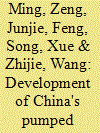

|
|
|
|
|
| Publication |
2013.
|
| Summary/Abstract |
With the rapid development of the Chinese economy and society, differences in the electric power system load between the peak and valley values are increasing, and inefficient small capacity coal-fired plant units must be involved in load adjustment because gas units and pumped storage units that act as peak-load units are lacking. In addition, due to concerns about energy saving and emissions reduction, clean energy sources are rapidly being developed and deployed. This presents a significant challenge for the construction and planning of peaking power solutions in China. Pumped storage plants provide a means of reducing the peak-to-valley difference and increasing the deployment of wind power, solar photovoltaic energy and other clean energy generation into the grid. Pumped storage plants represent the most mature approach among the peaking power sources and thus are one of China's major investments for the future. This paper presents China's current development of pumped storage plants, their role in the electric power system, the management models for pumped storage plants and the electricity price patterns utilising them. Here, we also analyse China's future plans for pumped storage plants, including the influencing factors and related policies.
|
|
|
|
|
|
|
|
|
|
|
|
|
|
|
|
| 8 |
ID:
191132


|
|
|
| 9 |
ID:
191131
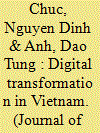

|
|
|
| 10 |
ID:
191366
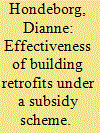

|
|
|
|
|
| Summary/Abstract |
While retrofitting buildings is one of the key elements of reaching climate and energy goals, it is burdened by insufficient speed and depth. Governments have attempted to accelerate deep retrofits via subsidies, but scant evidence exists on these policies’ effectiveness. In this study, we investigate the effectiveness of retrofitting subsidies by using a range of econometric techniques and a unique dataset of over 400 Swiss buildings with 19,000 observations over 11 years. Specifically, we analyze whether retrofits reduce energy consumption, whether subsidized retrofits lead to deeper retrofits than non-subsidized retrofits, and we differentiate the impact by subsidy amount. We find that retrofits reduce average energy use by 10–20%, that the achieved savings through subsidized and non-subsidized retrofits do not differ significantly, and that the subsidy amount is correlated to a reduction in energy use by 0.42 CHF per kWh over a period of 20 years. Our study highlights the importance of policies that enhance retrofit depth, the need to further investigate the causes of the wide variation in retrofitting results, and to consider effectiveness studies within the policy design.
|
|
|
|
|
|
|
|
|
|
|
|
|
|
|
|
| 11 |
ID:
192761
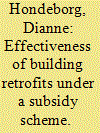

|
|
|
|
|
| Summary/Abstract |
While retrofitting buildings is one of the key elements of reaching climate and energy goals, it is burdened by insufficient speed and depth. Governments have attempted to accelerate deep retrofits via subsidies, but scant evidence exists on these policies’ effectiveness. In this study, we investigate the effectiveness of retrofitting subsidies by using a range of econometric techniques and a unique dataset of over 400 Swiss buildings with 19,000 observations over 11 years. Specifically, we analyze whether retrofits reduce energy consumption, whether subsidized retrofits lead to deeper retrofits than non-subsidized retrofits, and we differentiate the impact by subsidy amount. We find that retrofits reduce average energy use by 10–20%, that the achieved savings through subsidized and non-subsidized retrofits do not differ significantly, and that the subsidy amount is correlated to a reduction in energy use by 0.42 CHF per kWh over a period of 20 years. Our study highlights the importance of policies that enhance retrofit depth, the need to further investigate the causes of the wide variation in retrofitting results, and to consider effectiveness studies within the policy design.
|
|
|
|
|
|
|
|
|
|
|
|
|
|
|
|
| 12 |
ID:
125750


|
|
|
|
|
| Publication |
2013.
|
| Summary/Abstract |
We use a newly developed bottom-up model of the entire Canadian energy system (TIMES-Canada) to assess potentials for electrification of the road transport sector. A special emphasis has been put on the modelling of the Canadian road transport, by considering a variety of vehicles for passenger and freight transportation. Besides a business-as-usual (baseline) scenario, we have analysed an energy policy scenario imposing targets for electric vehicle penetration and a climate policy scenario imposing targets for greenhouse gas emission reduction. Our analysis shows on the one hand that electric vehicles penetrate notably the passenger vehicle market after 2040 in the baseline scenario and after 2030 in the energy policy scenario (following the assumed penetration targets). On the other hand, the assumed climate policy forces a stronger penetration of electric vehicles for passenger transportation, with a progressive phasing out of internal combustion engine vehicles, whereas the latter vehicles remain dominant for freight transportation but with a shift away of fossil fuels and in favour of biofuels. A sensitivity analysis on the (assumed) evolution of electric vehicles over time confirms these general trends.
|
|
|
|
|
|
|
|
|
|
|
|
|
|
|
|
| 13 |
ID:
186452
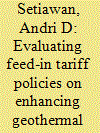

|
|
|
|
|
| Summary/Abstract |
Geothermal is vital for sustainably meeting Indonesia's energy demand, given its estimated massive reserves potential equivalent to 24 GW of electricity. The Indonesian government has set geothermal contributions to the national energy mix at 7,241.5 MW by 2025 and 17,546 MW by 2050, despite harnessing such vast potential needing significant investment. To that goal, the government established a feed-in tariff (FIT) mechanism to encourage private sector investment in geothermal development. However, FIT has undergone significant alterations in a short period. Moreover, various complicating factors—bureaucracy, social, and technical—exist alongside FIT implementation. Therefore, the extent that FIT can effectively enhance geothermal development in Indonesia should be challenged with further investigation. This study explores the efficacy of FIT policies for geothermal electricity by comparing the performance of several FIT schemes in terms of their impact on the government's target achievement. This study combines the policy analysis framework with system dynamics modeling to understand the dynamic interaction of FIT policy and other important components in geothermal development. The findings show that modest bureaucracy and public support are required. Furthermore, to enhance geothermal development more effectively, FIT should be at least 11 cents US$/kWh and accompanied by technical breakthroughs and government-funded exploration activities.
|
|
|
|
|
|
|
|
|
|
|
|
|
|
|
|
| 14 |
ID:
115637
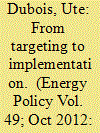

|
|
|
|
|
| Publication |
2012.
|
| Summary/Abstract |
This paper proposes to evaluate the efficiency of fuel poverty policies by looking at them as a three-step process. These steps are policy targeting, identification of households and implementation of measures. Each of these steps are costly and can face feasibility problems. This is particularly true in the case of fuel poverty policies, because of the multidimensional aspect of fuel poverty. Therefore, public policies in that field are necessarily imperfect, and this should be taken into account in the analysis of policies. This three-step framework is applied to the French fuel poverty policy, which has been developed in 2010. As its practical modalities of implementation are still under discussion, we mainly discuss the choices made in terms of targeting and highlight the role of identification of fuel poor households as a key factor for the success of that policy. The general idea behind this discussion is that the efficiency of such policies has to be viewed in a comprehensive way, which includes the three policy steps.
|
|
|
|
|
|
|
|
|
|
|
|
|
|
|
|
| 15 |
ID:
127207
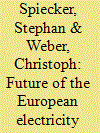

|
|
|
|
|
| Publication |
2014.
|
| Summary/Abstract |
the ongoing transformation of the European energy system comes along with new challenges, notably increasing amounts of power generation from intermittent sources like wind and solar. How current objectives for emission reduction can be reached in the future and what the future power system will look like is, however, not fully clear. In particular, power plant investments in the long run and power plant dispatch in the short run are subject to considerable uncertainty. Therefore an approach is presented which allows electricity market development to be assessed in the presence of stochastic power feed-in and endogenous investments in power plants and renewable energies. To illustrate the range of possible future developments, five scenarios for the European electricity system up to 2050 are investigated. Both generation investments and dispatch as well as utilization of transmission lines are optimized for these scenarios and additional sensitivity analyses are carried out.
|
|
|
|
|
|
|
|
|
|
|
|
|
|
|
|
| 16 |
ID:
168646
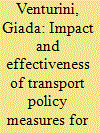

|
|
|
|
|
| Summary/Abstract |
The unsustainable growth in global transport activity is straining planet's resources and ecosystems. Hence, there is a need to promote technological developments, regulatory instruments and social changes to reduce the impact of mobility demand on energy use and environment. The current paper aims at assessing the impact and effectiveness of transport policy measures in reaching emission reduction targets for the case of the integrated energy and transport system of Denmark. Our analysis of policy scenarios is performed in collaboration with experts, stakeholders and citizens, and facilitated by a newly developed Scenario Interface tool linked to the energy system model TIMES-DK. Market signals, in the form of taxes on CO2 and fossil fuels, retain the highest impact in lowering the carbon emissions from the transport sector, while the promotion of Mobility-as-a-Service is the most cost-effective measure among those analysed. Finally, we discuss the implications of combining instruments into policy packages and emphasise the urgency of addressing technology and policy solutions for the maritime and aviation sectors.
|
|
|
|
|
|
|
|
|
|
|
|
|
|
|
|
| 17 |
ID:
149972
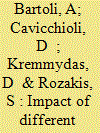

|
|
|
|
|
| Summary/Abstract |
The growing demand of maize silage for biogas production in Northern Italy has triggered an intense debate concerning land rents, maize prices and their possible negative consequences on important agri-food chains. The aim of this work is to quantify the extent to which the rapid spread of biogas raised the maize price at regional level, increasing the demand of land for energy crops. For this purpose we applied a partial-equilibrium framework simulating the agricultural sector and the biogas industry in Lombardy, under two alternative schemes of subsidization policy. Results show that policy measures implemented in 2013 – reducing the average subsidy per kWh – may contribute to enforce the complementarity of the sector with agri-food chains, decreasing the competition between energy and non-energy uses. Compared to the old scheme, maize demand for biogas would decrease, lessening the market clearing price (as well as feed opportunity cost for livestock sector) and reducing land demand for energy purposes.
|
|
|
|
|
|
|
|
|
|
|
|
|
|
|
|
| 18 |
ID:
125839
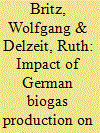

|
|
|
|
|
| Publication |
2013.
|
| Summary/Abstract |
As part of its climate policy, Germany promotes the production of biogas via its so-called Renewable-Energy-Act (EEG). The resulting boost in biogas output went along with a significant increase in production of green maize, the dominant feedstock. Existing studies of the EEG have analysed its impacts on German agriculture without considering market feedback. We thus expand existing quantitative analysis by also considering impacts on European and global agricultural markets, land use and the environment by combining a detailed location model for biogas plants, the Regionalised Location Information System-Maize (ReSi-M2012), with a global Partial Equilibrium model for agriculture, the Common Agricultural Policy Regional Impact (CAPRI) model. Our results indicate that the German biogas production is large enough to have sizeable impacts on global agricultural markets in prices and quantities, causing significant land use change outside of Germany. While profits in the agricultural sector increase, food consumer face higher prices, and subsidies for biogas production are passed on to electricity consumers. The German biogas program, as long as it is almost entirely based on non-waste feedstocks, is probably not a promising avenue towards a GHG-saving renewable energy production, but a rather expensive one.
|
|
|
|
|
|
|
|
|
|
|
|
|
|
|
|
| 19 |
ID:
171394


|
|
|
|
|
| Summary/Abstract |
Shifting from fossil to clean energy sources is a major global challenge, but in particular for those countries with substantial fossil-fuel reserves and economies depending on fossil-fuel exports. Here we introduce an improved framework for renewable energy planning and decision-making to help such countries to more effectively harness their abundant renewable energy resources. We use Iran as a case for the analysis. The framework includes identifying and removing barriers that prevent the use of renewables. It is based on combining two models: Benefit, Opportunity, Cost, Risk (BOCR) and Analytic Network Process (ANP) models. In the analyses, the mutual weight of strategic criteria is employed such as technology, economy, energy vulnerability, security, global effects, and human wellbeing. Using the integrated model, we find that solar energy would be the preferential renewable energy source for Iran. Also, the role of infrastructures, policies, and administrative structures in renewable energy to facilitate their development was analyzed. The renewable energy policy-making framework presented is applicable to other countries as well.
|
|
|
|
|
|
|
|
|
|
|
|
|
|
|
|
| 20 |
ID:
176840


|
|
|
|
|
| Summary/Abstract |
The purpose of this research is to investigate policy synergies and market interdependencies in the field of alternative powertrain technologies. The methodology is based on a simulation model grounded on system dynamics, a method that focuses on the structure (particularly feedback processes) and behavior over time of complex systems. The impacts of four policy measures on the uptake of electric cars in six countries (China, France, Germany, India, Japan and the United States), each segmented in five consumer groups, are explored. We observe that the additive impact of individual policies is lower than the impact of a corresponding policy package and that the impact of a policy package is greater if pursued by countries jointly. The implications of these findings are that the uptake of electric powertrains may depend not only on the combined impact of country-specific policy measures but also on the joint effect of policies in key electric car markets. The originality of this research arises from the endogenization of the electric car battery price evolution by explicitly modeling policy packages in six major car markets and interlinking them.
|
|
|
|
|
|
|
|
|
|
|
|
|
|
|
|
|
|
|
|
|